The Nucleoid
The nucleoid (meaning nucleus-like) is an irregularly-shaped region within the cell of a prokaryote that contains all or most of the genetic material. In contrast to the nucleus of a eukaryotic cell, it is not surrounded by a nuclear membrane. The genome of prokaryotic organisms generally is a circular, double-stranded piece of DNA, of which multiple copies may exist at any time. The length of a genome varies widely, but is generally at least a few million base pairs.

Prokaryote cell nucleoid
Prokaryote cell (right) showing the nucleoid in comparison to a eukaryotic cell (left) showing the nucleus.
The nucleoid can be clearly visualized on an electron micrograph at high magnification, where it is clearly visible against the cytosol. Sometimes even strands of what is thought to be DNA are visible. The nucleoid can also be seen under a light microscope.by staining it with the Feulgen stain, which specifically stains DNA. The DNA-intercalating stains DAPI and ethidium bromide are widely used for fluorescence microscopy of nucleoids.
Experimental evidence suggests that the nucleoid is largely composed of about 60% DNA, plus a small amount of RNA and protein. The latter two constituents are likely to be mainly messenger RNA and the transcription factor proteins found regulating the bacterial genome. Proteins helping to maintain the supercoiled structure of the nucleic acid are known as nucleoid proteins or nucleoid-associated proteins, and are distinct from histones of eukaryotic nuclei. In contrast to histones, the DNA-binding proteins of the nucleoid do not form nucleosomes, in which DNA is wrapped around a protein core. Instead, these proteins often use other mechanisms, such as DNA looping, to promote compaction.
The Genophore
A genophore is the DNA of a prokaryote. It is commonly referred to as a prokaryotic chromosome. The term "chromosome" is misleading, because the genophore lacks chromatin. The genophore is compacted through a mechanism known as supercoiling, but a chromosome is additionally compacted through the use of chromatin. The genophore is circular in most prokaryotes, and linear in very few. The circular nature of the genophore allows replication to occur without telomeres. Genophores are generally of a much smaller size than Eukaryotic chromosomes. A genophore can be as small as 580,073 base pairs (Mycoplasma genitalium). Many eukaryotes (such as plants and animals) carry genophores in organelles such as mitochondria and chloroplasts. These organelles are very similar to true prokaryotes.